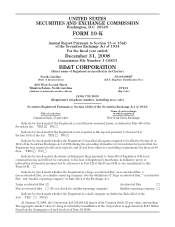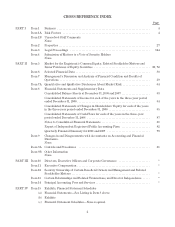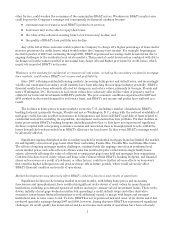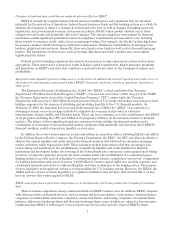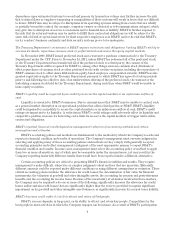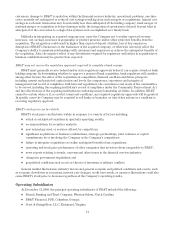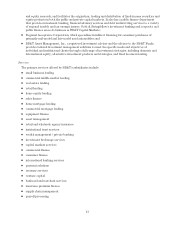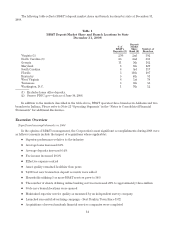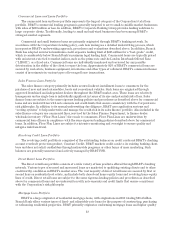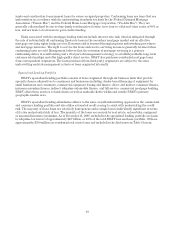BB&T 2008 Annual Report Download - page 10
Download and view the complete annual report
Please find page 10 of the 2008 BB&T annual report below. You can navigate through the pages in the report by either clicking on the pages listed below, or by using the keyword search tool below to find specific information within the annual report.in the CPP, BB&T is required to meet certain standards for executive compensation as set forth under the
EESA, and related interim regulations. The recently enacted ARRA requires the Treasury Department to adopt
additional standards with respect to executive compensation and governance that may impact certain of BB&T’s
executive officers and employees. Such restrictions imposed as a result of the Treasury Department’s investment
in BB&T, in addition to other competitive pressures, may have an adverse effect on the ability of BB&T to attract
and retain skilled personnel, resulting in BB&T not being able to hire the best people or to retain them.
BB&T relies on other companies to provide key components of its business infrastructure.
Third party vendors provide key components of BB&T’s business infrastructure such as internet
connections, network access and mutual fund distribution. While BB&T has selected these third party vendors
carefully, its does not control their actions. Any problems caused by these third parties, including those which
result from their failure to provide services for any reason or their poor performance of services, could adversely
affect BB&T’s ability to deliver products and services to its customers and otherwise to conduct its business.
Replacing these third party vendors could also entail significant delay and expense.
Significant litigation could have a material adverse effect on BB&T.
BB&T faces legal risks in its business, and the volume of claims and amount of damages and penalties
claimed in litigation and regulatory proceedings against financial institutions remain high. Substantial legal
liability or significant regulatory action against BB&T may have material adverse financial effects or cause
significant reputational harm to BB&T, which in turn could seriously harm BB&T’s business prospects.
BB&T faces systems failure risks as well as security risks, including “hacking” and “identity theft.”
The computer systems and network infrastructure BB&T and others use could be vulnerable to unforeseen
problems. These problems may arise in both the Company’s internally developed systems and the systems of its
third-party service providers. The Company’s operations are dependent upon its ability to protect computer
equipment against damage from fire, power loss or telecommunication failure. Any damage or failure that causes
an interruption in the Company’s operations could adversely affect BB&T’s business and financial results. In
addition, the Company’s computer systems and network infrastructure present security risks, and could be
susceptible to hacking or identity theft.
Differences in interpretation of tax laws and regulations may adversely impact BB&T’s financial statements.
Local, state or federal tax authorities may interpret tax laws and regulations differently than BB&T and
challenge tax positions that BB&T has taken on its tax returns. This may result in the disallowance of deductions
or credits, and/or differences in the timing of deductions and result in the payment of additional taxes, interest or
penalties that could materially affect BB&T’s performance.
Changes in accounting standards could materially impact BB&T’s financial statements.
From time to time the Financial Accounting Standards Board (“FASB”) changes the financial accounting and
reporting standards that govern the preparation of BB&T’s financial statements. These changes can be hard to
predict and can materially impact how the Company records and reports its financial condition and results of
operations. In some cases, the Company could be required to apply a new or revised standard retroactively,
resulting in changes to previously reported financial results, or a cumulative charge to retained earnings.
BB&T may not be able to successfully integrate bank or nonbank mergers and acquisitions.
Difficulties may arise in the integration of the business and operations of bank holding companies, banks and
other nonbank entities BB&T acquires and, as a result, the Company may not be able to achieve the cost savings
and synergies that it expects will result from such transactions. Achieving cost savings is dependent on
consolidating certain operational and functional areas, eliminating duplicative positions and terminating certain
agreements for outside services. Additional operational savings are dependent upon the integration of the
acquired or merged entity’s businesses with BB&T or one of BB&T’s subsidiaries, the conversion of core
operating systems, data systems and products and the standardization of business practices. Complications or
difficulties in the conversion of the core operating systems, data systems and products may result in the loss of
10

